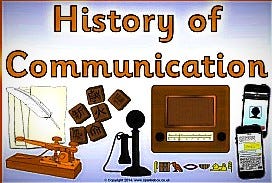
The first means of communication was, of course, the spoken word. Around 3200BC writing was invented in ancient China, other civilizations like the Mayans also developed a system of writing.
This was followed by the invention of the alphabet, which led to people writing letters, books etc.
In 1450 Johannes Gutenberg invented a printing press with metal movable type. Before the invention of the printing press, any writings and drawings had to be completed by hand, painstakingly. Several different materials were used to transcribe books: clay and papyrus, wax, and parchment. Such work was usually reserved for the educated monks who lived in monasteries.

This invention led to the mass printing of books, newspapers, etc. Due to this, the cost of books reduced and soon almost every household had books which led to rising in the literacy rate.
Due to the ready availability of books many people started getting more into science which led to the development of telecommunication- the transmission of signals over a distance for the purpose of communication — began thousands of years ago with the use of smoke signals and drums in Africa, America and parts of Asia.
Before the invention of the telegraph, information was transmitted by means of drum beats, flares or flags. This method of communication was very unreliable as they depended on a lot of unpredictable factors. The invention of the telegraph in 1831 by John Henry revolutionalised communication.
However, the telegraph had some drawbacks. This was improved upon by the invention of the Morse code and the electrical telegraph by Samuel Morse and John Henry was one of the most important inventions of the 18th century.

As with many innovations, the idea for the telephone came along far sooner than it was brought to reality. Italian innovator Antonio Meucci is credited with inventing the first basic phone, and Frenchman Charles Bourseul devised a phone, Alexander Graham Bell won the first U.S. patent for the device. In 1877–78, the first telephone line was constructed, the first switchboard was created and the first telephone exchange was in operation. In 1880, Bell merged his company with others to form the American Bell Telephone Company and in 1885 American Telegraph and Telephone Company (AT&T) was formed which dominated telephone communications for the next century.

The next advancement in telecommunications was radio, the first wireless mode of communication. Radios send messages by radio waves instead of wires. German scientist Heinrich Hertz proved the existence of radio waves, which occur in nature. In 1895, Gugliemo Marconi invented “the wireless telegraph” while experimenting in his parents’ attic. He used radio waves to transmit Morse code and the instrument he used came to be known as the radio.
The next in line was the invention of the television. It is one of the most prominent inventions of the 20th Century. It has become one of the most common ways people view the larger world beyond them, as well as being one of the best ways for people to escape from the world. It has gone through a lot of changes over the years from being a box where pictures were played in black and white to a sleek device where you can stream Netflix!
While there were many changes prior to 1973, the invention of the mobile phone reformed communication methods drastically. Communication was no longer location bound. A telephone number was associated with a person, not a place.

Mobile phones work on the principle of radio waves. the phone sends data in the form of an electromagnetic field via air at the speed of light. The wave when sent is not direction oriented, scattering equally in a lot of directions. This causes the phone to be dangerous as we absorb nearly half the emf emitted.
In the late 1970s, the first ship to shore satellite communication was established making it safer for sailors at sea.
Nearly a decade after the invention of the mobile, the internet came to be. With the internet, came huge changes. Along with the internet, came emails, which gave people the opportunity to write to others within a matter of minutes.
Eventually, other platforms were developed like blogs and social networking ones. This helped improve general communication.
On the internet messages are spread, the news is shared, important and controversial issues are discussed, and even recruitments happen.
The internet was based on the concept, ‘ a network of networks’.

In 1998, the first satellite mobile phone was launched by a company named Iridium. The 64 satellites launched created its own network in space to provide unbeatable coverage to customers. It is mainly used in rough terrain where one would normally not get coverage. While its features are limited, it is mostly used in military camps to maximise the scope of contact.
Interestingly enough, it wasn’t only wires and networks that were used to exchange data. In 1965, it was theorised that light could be used to transmit information by reducing the impurities present. In 1970, this was successfully achieved and that’s how the modern optic fibre was born. While its idea was dated back to the 1850s, it was only later on that the fibre was capable of transmitting data. Currently, optic fibre is the dominant carrier of electronic information. It forms the backbone of modern communication infrastructure.
It is very impressive to see how we have progressed from communicating via sounds to the sophisticated technology we use today. From struggling to communicate with the person right next to us, we have reached a level where we can contact people thousands of miles away from us whenever we want.

Our systems of communication have developed to such an extent that we can now communicate with objects in space as well. If the Mars mission works out according to NASA’s plans we will have inter-space communication as well!
References:
https://www.history.com/topics/inventions/telegraph https://www.elon.edu/e-web/predictions/150/1870.xhtml https://www.britannica.com/technology/broadcasting https://www.knowitall.org/document/history-radio-kids-work https://www.tevelec.com/history https://www.history.com/news/who-invented-the-internet
Originally published at https://blog.isavit.club.








